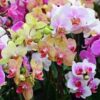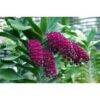# How to Treat Mold on Dendrobium Anosmum Orchids

The Dendrobium anosmum, also known as the Đai Châu orchid, is a beloved species admired for its stunning blooms and fragrant flowers. However, like many plants, it is susceptible to various problems, including mold growth. Mold can be detrimental to the health of your orchids, potentially leading to reduced growth, blooming issues, and even plant death if not addressed promptly. This comprehensive guide will explore the causes of mold growth on Đai Châu orchids, its impact, and effective treatment and prevention strategies.
## Understanding Mold and Its Causes
Mold is a type of fungus that thrives in damp, humid environments. For orchids, particularly the Dendrobium anosmum, mold can occur for several reasons:
### 1. Overwatering
Overwatering is one of the most common causes of mold growth on orchids. When the roots of your Dendrobium anosmum remain soggy for extended periods, it creates an ideal environment for mold and other fungi to flourish.
### 2. Poor Air Circulation
Orchids require good air circulation to thrive. If they are placed in a location with stagnant air, moisture can build up around the leaves and roots, promoting mold growth.
### 3. High Humidity Levels
While orchids generally prefer higher humidity, excessive humidity—especially in combination with poor air circulation—can lead to mold problems. The ideal humidity range for Dendrobium anosmum is typically between 50% and 70%.
### 4. Organic Material
Using organic materials, such as bark or moss, in your orchid’s potting mix can provide a nutrient-rich environment for mold. While these materials are often beneficial for orchids, they can also retain moisture and promote mold if not managed properly.
### 5. Contaminated Tools or Pots
Using contaminated tools, pots, or potting mixes can introduce mold spores to your orchid. It is essential to ensure that all equipment is clean and sterilized before use.
## Identifying Mold on Your Orchid
Recognizing mold on your Dendrobium anosmum is crucial for effective treatment. Here are some common signs to look out for:
### 1. Visual Signs
– **White, fuzzy growth**: This is often the most common form of mold, appearing like a cottony substance on leaves or in the potting mix.
– **Black or brown spots**: These can indicate the presence of mold or other fungal infections, often resulting in leaf rot.
– **Discoloration of leaves**: Yellowing or browning leaves can be a sign of mold-induced stress on the plant.
### 2. Smell
Mold can produce a musty odor, particularly if it has established a strong presence in the potting medium. If you notice an unpleasant smell emanating from your orchid, it may be a sign of mold growth.
### 3. Wilting or Dropping Leaves
Mold can stress the plant, leading to wilting or dropping leaves. If your Dendrobium anosmum shows signs of distress, it’s essential to investigate for mold.
## Steps to Treat Mold on Dendrobium Anosmum Orchids
If you discover mold on your Dendrobium anosmum, taking prompt action is essential to prevent further damage. Follow these steps to effectively treat mold growth:
### Step 1: Assess the Situation
Before taking any action, assess the extent of the mold problem. Check the roots, leaves, and potting medium for signs of mold growth. If mold is confined to the potting medium, you may need to repot the orchid. If it’s on the leaves, treatment may involve more localized measures.
### Step 2: Remove Affected Areas
Carefully remove any visible mold with a soft brush or cloth. If the mold is on the leaves, gently wipe it away to prevent further spread. Use a sterilized pair of scissors or shears to cut away any affected leaves or roots. Ensure that all tools are disinfected with rubbing alcohol or a bleach solution before and after use to prevent cross-contamination.
### Step 3: Repot the Orchid
If mold is found extensively in the potting medium, consider repotting your Dendrobium anosmum. Follow these steps for repotting:
1. **Choose the Right Pot**: Select a clean pot with drainage holes to ensure proper water flow.
2. **Select Appropriate Potting Medium**: Use a fresh, sterile potting mix specifically designed for orchids. Common materials include orchid bark, coconut coir, or perlite.
3. **Remove Old Potting Medium**: Gently take the orchid out of its old pot and carefully remove as much of the old medium as possible. Be cautious not to damage the roots during this process.
4. **Inspect the Roots**: Check the roots for signs of rot or damage. Healthy roots should be firm and white or green in color. Trim away any dead or mushy roots.
5. **Repot the Orchid**: Place the orchid in its new pot, adding fresh potting medium around the roots. Ensure that the plant is positioned correctly and that the roots are adequately covered.
6. **Water Sparingly**: After repotting, water the orchid lightly to avoid over-saturation. Allow the medium to dry out slightly before watering again.
### Step 4: Improve Air Circulation
Improving air circulation around your Dendrobium anosmum can help prevent mold from returning. Consider the following methods:
– **Placement**: Move the orchid to a location with better airflow, such as near a fan or open window.
– **Use of Fans**: Small oscillating fans can help circulate air in the growing area, reducing humidity levels around the plant.
– **Spacing**: Ensure that your orchids are not overcrowded, allowing each plant sufficient space for air circulation.
### Step 5: Adjust Humidity and Watering Practices
Maintaining the right humidity and watering practices is crucial in preventing mold.
– **Humidity Control**: If humidity levels are consistently above 70%, consider using a dehumidifier in the growing area. Alternatively, increase ventilation to lower humidity levels.
– **Watering Schedule**: Adjust your watering schedule to ensure the potting medium dries out between waterings. Check the medium’s moisture levels before watering to prevent over-saturation.
### Step 6: Monitor Environmental Conditions
Regularly monitor the environmental conditions of your orchid’s growing area. Ensure that temperature and humidity levels remain within the optimal range for Dendrobium anosmum:
– **Temperature**: The ideal temperature range is typically between 65°F (18°C) and 85°F (30°C) during the day and slightly cooler at night.
– **Humidity**: Aim for humidity levels between 50% and 70%, adjusting as needed based on seasonal changes.
### Step 7: Use Natural Fungicides
If mold persists despite your efforts, consider using natural fungicides. Here are a few options:
– **Baking Soda Solution**: Mix one tablespoon of baking soda with a quart of water. Spray this solution onto the affected areas, ensuring complete coverage. Baking soda helps to create an alkaline environment that is unfavorable for mold growth.
– **Neem Oil**: Neem oil is a natural fungicide and insecticide that can help treat mold and prevent its recurrence. Dilute neem oil according to package instructions and spray it onto the affected areas.
– **Garlic Spray**: Garlic has natural antifungal properties. Blend a few cloves of garlic with water, strain the mixture, and spray it onto the mold-affected areas.
### Step 8: Regular Maintenance
Preventing mold growth on your Dendrobium anosmum involves regular maintenance and care:
– **Routine Inspections**: Regularly check your orchids for signs of mold or disease. Early detection is key to effective treatment.
– **Cleaning Leaves**: Wipe the leaves with a damp cloth to remove dust and debris that can harbor mold spores.
– **Proper Fertilization**: Avoid over-fertilizing, as this can contribute to excess growth and increased humidity around the roots. Use a balanced orchid fertilizer at recommended intervals.
## Preventing Future Mold Growth
Taking proactive measures can significantly reduce the risk of mold growth on your Dendrobium anosmum orchids. Here are some tips for prevention:
### 1. Choose the Right Growing Medium
Using a well-draining potting medium is crucial for preventing mold. Choose a mix specifically formulated for orchids that allows excess moisture to escape while retaining some moisture for the roots.
### 2. Water Wisely
Water your orchids in the morning to allow ample time for moisture to evaporate during the day. Avoid watering in the evening, which can lead to prolonged dampness overnight.
### 3. Maintain Good Airflow
Ensure that your orchids are placed in a well-ventilated area with sufficient airflow. Avoid overcrowding your plants to promote airflow around each orchid.
### 4. Monitor Temperature and Humidity
Keep a close eye on temperature and humidity levels, adjusting as necessary to create an optimal environment for your orchids. Using hygrometers and thermometers can help you track these levels.
### 5. Clean Tools and Pots
Always clean and disinfect your tools and pots before use. This practice helps prevent the introduction of mold spores and other pathogens to your orchids.
### 6. Educate Yourself
Stay informed about the best practices for orchid care and mold prevention. Join local orchid societies or online forums where you can share experiences and learn from other orchid enthusiasts.
## Conclusion
Mold growth on Dendrobium anosmum orchids can be a concerning issue, but with prompt action and proper care, you can effectively treat and prevent it. By understanding the causes of mold, implementing best practices for orchid care, and regularly monitoring your plants, you can ensure that your Đai Châu orchids remain healthy and vibrant. Remember that regular maintenance, proper watering techniques, and a suitable
growing environment are key to the long-term health of your orchids. With diligence and care, your Dendrobium anosmum will thrive and reward you with its beautiful blooms for years to come.

